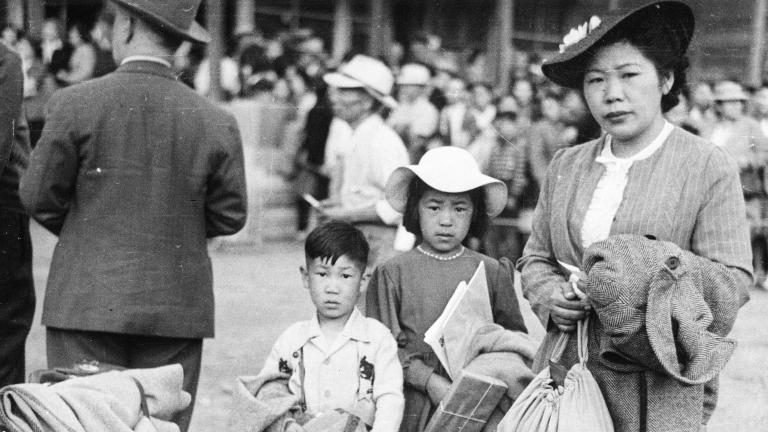Before the outbreak of the Second World War, Lena Hayakawa lived what she describes as a very idyllic life.
Japanese Canadian internment and the struggle for redress
By Matthew McRae
Published: May 19, 2017
Tags:

Photo: Library and Archives Canada, C-046355
Story text
Hayakawa was born in British Columbia and until she was 11, she lived on her father’s strawberry farm in the countryside. She told me it was a simple living, but her family was happy. That all changed on December 7, 1941. On that day, Japanese planes bombed the American naval base at Pearl Harbour, Hawai’i, entering the Second World War on the side of the Axis powers of Germany and Italy. This meant Canada was now at war with Japan.
At that time, there was a sizeable Japanese Canadian population in British Columbia. Canadian military officials and the RCMP felt that the Japanese Canadian population posed no threat and opposed taking any punitive action against them. The federal government, however, disagreed. Immediately after the attack on Pearl Harbour, Canadian officials in B.C. seized all fishing boats owned by Japanese Canadians, 1,800 in total, and shut down all Japanese language newspapers and schools. All cameras and short‐wave radios belonging to Japanese Canadians were confiscated, and a curfew was implemented to keep them home at night.
A few weeks later, in January of 1942, the federal government passed an order calling for the removal of Japanese Canadian men between the ages 18 to 45 from a special “protected zone” running up and down the B.C. coast. By March of 1942, the government had expanded the removal to include all Japanese Canadians in the protected zone, in which approximately 90 percent of the Japanese Canadian population was living. In total, some 23,000 men, women and children were forced from their homes, despite the fact that over 75 percent of them were Canadian‐born or naturalized citizens. They were first sent to a makeshift holding and transit centre in Hastings Park Exhibition Grounds in Vancouver, but after weeks or months in the centre, the majority were sent to isolated internment camps in the B.C. interior. To accomplish this removal, the federal government used a piece of legislation called theWar Measures Act, which granted the state sweeping powers to suspend the basic rights and freedoms of Canadian citizens.
Approximately 12,000 people were forced to live in the internment camps. The men in these camps were often separated from their families and forced to do roadwork and other physical labour. About 700 Japanese Canadian men were also sent to prisoner of war camps in Ontario. Finally, another 4,000 or so Japanese Canadians were sent to work on sugar beet farms in Alberta and Manitoba, to help fill labour shortages. This is what happened to Lena Hayakawa’s family.
Hayakawa recalls taking a train to Winnipeg, and then travelling to Dufrost, Manitoba, where her family worked harvesting sugar beets. She told me life there was very hard. Her whole family worked in the field, caring for and then harvesting the sugar beets. The whole family lived in a very small log cabin; Hayakawa remembers that when she was sleeping at night, she could see outside through the spaces between the logs:
In the wintertime, there was only a wood stove… the bathroom and everything was all outside and there was no bathtub. In the wintertime, my mother had to bring the snow in the house and melt it.
After the war, Hayakawa’s family moved to Whitemouth, Manitoba and tried to begin anew. She never saw her family’s farm in B.C. again. In fact, Japanese Canadians were banned from returning to B.C. after the War ended, and about 4,000 were exiled to Japan – a war‐ravaged country many of them had never seen. To make matters even worse, Japanese Canadians lost almost all their property, with little to no compensation – the government had sold it off during the War, and used the proceeds to finance the internment.
It was only on April 1, 1949 that Japanese Canadians were again allowed to move freely across Canada. Before that date, the community had begun to organize. In 1947, the National Association of Japanese Canadians (NAJC) was formed. In the coming decades, Japanese Canadians, led by the NAJC, would call upon the federal government to acknowledge the human rights violations that were committed against their community during the Second World War.
Despite being shy, Hayakawa herself became involved in the struggle for redress, sharing her family’s story at public meetings and events. “When [the NAJC] had a meeting, they asked me if I would do a little speech and I said “Oh, I’m not very good at speeches,” but I tried my best and did it.”
Hayakawa and many other Japanese Canadians felt that the fight for redress needed to go beyond the hurt that had been caused to their community. They wanted to ensure that no one would have their rights violated in this way ever again. In November of 1984, the NAJC submitted a brief entitled “Democracy Betrayed: The Case for Redress,” calling on the federal government to redress the injustices of the 1940s. They based part of their appeal on the Canadian Charter of Rights and Freedoms, saying:
"As a visible minority that has experienced legalized repression under the War Measures Act, we urge the Government of Canada to take such steps as are necessary to ensure that Canadians are never again subjected to such injustices. In particular, we urge that the fundamental human rights and freedoms set forth in the Canadian Charter of Rights and Freedoms be considered sacrosanct, non‐negotiable and beyond the reach of any arbitrary legislation such as the War Measures Act."

In August of 1988, after extensive discussions, a redress agreement was reached between the NAJC and the federal government. On September 22, 1988, then‐Prime Minister Brian Mulroney formally apologized in the House of Commons to all Japanese Canadians.
In addition to the apology, the government also offered $21,000 to each individual directly affected by the internment, the creation of a community fund, pardons for those who had been wrongfully imprisoned during the War, and Canadian citizenship for Japanese Canadians and their descendants who had been wrongfully deported to Japan at the War’s end. Last but not least, the agreement promised $24 million towards the creation of what is now the Canadian Race Relations Foundation, whose purpose is to work for the elimination of all forms of racial discrimination in Canada.
For Lena Hayakawa, it is important for Canadians to hear tragic stories of the internment of Japanese Canadians. She knows that when we are silent about human rights violations, it is easier for them to disappear from history. When one violation is erased from our past, it makes it easier to deny others. It is everyone’s duty to speak out. She explained how redress helped her and many others to open up about their experience, so that future generations would understand what happened right here in Canada.

Lena Hayakawa and her family were forced to move to Manitoba and work on a sugar beet farm during the Second World War.
"When the redress came… we started to come out with all our stories for people to know what happened to us. Then our children would know what happened. Otherwise, they’ll never know."
The story of the internment of Japanese Canadians and the struggle for redress can be found in the Museum’s Canadian Journeys gallery. This article was written in part using research conducted by Mallory Richard, who worked at the Museum as both a researcher and a project coordinator.
Suggested citation
Suggested citation : Matthew McRae. “Japanese Canadian internment and the struggle for redress.” Canadian Museum for Human Rights. Published May 19, 2017. https://humanrights.ca/story/japanese-canadian-internment-and-struggle-redress